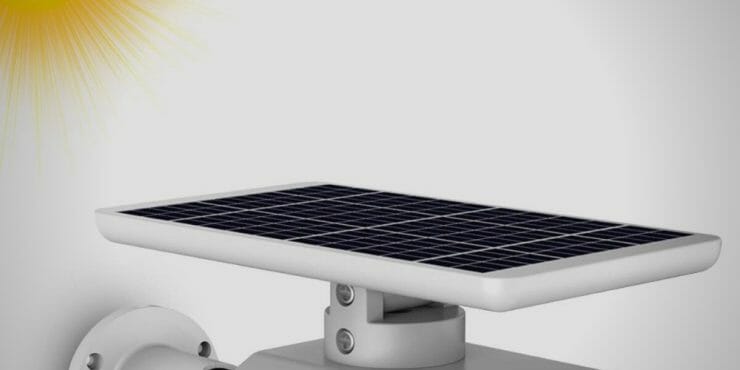Quick Navigation
- Materials Required
- Power Requirements
- Gauging The Supply Of Power
- Battery Lifespan
- Solar Panel Size
- The Solar Charge Controller
- Selecting the Solar Cable
- Preparing the Power Cord
- Installing the Solar Panel
- Wiring
- Additional Factors to Consider
- Best Wireless Cameras To Choose For The DIY Project
- FAQs
- To Buy or To Build? (Advantages & Disadvantages)
- Wrapping up
One of the most common gripes with security cameras is their high electric bills we simply cannot overlook just how expensive using store-bought wireless cameras can be due to those large electricity bills. Also, the large subscription bills could be a very large financial burden on some people.
So, what’s the solution? One of the best alternatives to a store-bought security camera is a DIY solar-powered wireless security camera. Making a DIY solar camera is pretty easy if you know the right method. This detailed guide will help you build a DIY security camera powered by solar energy.
Here is a step summary of building a DIY solar-powered security camera;
Step 1: Choose the right Voltage battery and connect it to the solar charger controller
Step 2: Connect the solar panels with the solar charge controller
Step 3: Install a wireless security camera like Reolink into the apparatus
Step 4: Construct a weather-proof box around the system to protect it from all the elements of weather including snow.
Below we’re going to go through more details on how to go and complete this process yourself starting with the power source!
Materials Required
Before you begin making a DIY solar security camera, you need to get a few items. You can get these items from any prominent e-commerce site such as Amazon, or nab them from your local hardware store.
1. Solar Panel: The solar panel will be used to power the camera.
2. Security Camera: Purchase any wireless security camera of your liking, such as a Reolink camera.
3. Battery: Make sure to buy solar batteries that can be quickly recharged. It should store adequate power for continuous recording and monitoring.
4. Battery Enclosure: Your battery can be exposed to harsh weather. To protect it from those, choose a good quality electrical enclosure for complete protection against weather conditions.
5. Solar Charge Controller: You’d need a solar charge controller to regulate power within the system.
Power Requirements
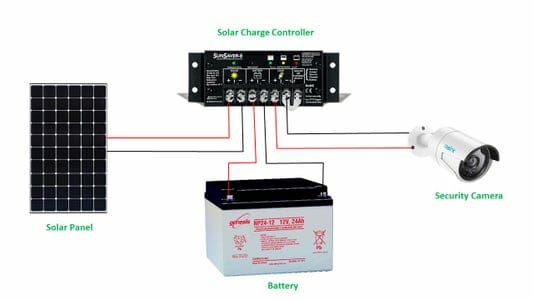
Before beginning the project, you’d be required to collect the main components that would eventually form the solar-powered security camera.
Gauging The Supply Of Power
Power is rated in watts, while voltage is rated in Volt or V. Before buying the components, ensure that you gather information on power rating, and use it to calculate the size requirements for both the battery and the solar panel for your security camera. For a camera that works on 12 VDC, you’d need a 12V battery. Likewise, if the camera works on 24 VDC, it will require a 24V battery.
Battery Lifespan
Your choice of the battery would determine the efficacy of the security camera system on many levels. For this kind of project, you have two options; Li-Ion and Deep Cycle Lead Acid. Both options have their fair share of benefits to offer. (1)
The lead-Acid battery is more of a budget option, as it is cheaper than Li-Ion. Although, the battery lifespan offered by Lead Acid is relatively less than what Li-Ion has to offer. Lead Acid would render good service for 2 to 5 years, while Li-Ion can be trusted with about 5 to 9 years of service. In addition to this, Li-Ion also happens to change faster than its competitor.
Needless to say, you’d have to pay considerably more for the wide-ranging benefits offered by Li-Ion.
While buying the battery, make sure to also purchase a weatherproof battery enclosure to protect it from environmental elements.
Solar Panel Size

Choosing the right size of solar panels is just as important as getting the power supply voltage right.
First, you need to ascertain the peak sun hours in your region. This would vary from area to area, so you might want to do some local research.
For optimum charging, choose a solar panel with either an equal voltage output to the battery or greater. For a 12V battery, a 12V solar panel should be bought.
The Solar Charge Controller
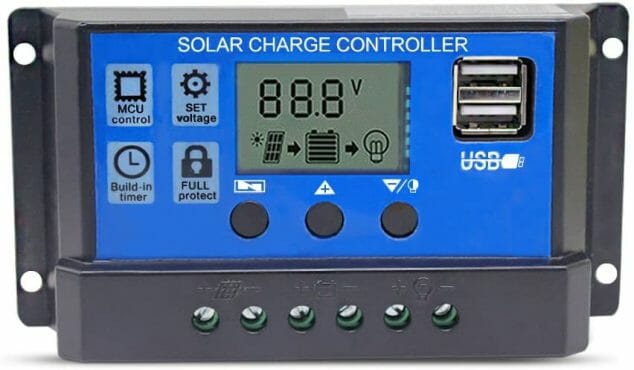
A solar charge controller regulates the power in the battery, and the voltage and current input from the solar panel. This component essentially strikes a balance in the charging of the system, and it is placed right between the battery and the panel. It prevents the batteries from being overcharged by regulating the rising voltage input from the panel.
The criteria for choosing the ideal solar charge controller is that the current rating is more than the short circuit current, after also considering the safety factor. Short circuit current is the maximum current that a PV panel can produce. (2)
Selecting the Solar Cable
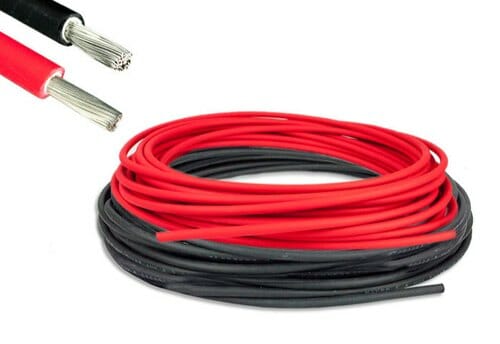
Solar cables will be the medium that connects the solar panels with the battery. It ensures that the current from the solar panels is connected to the battery with minimal loss.
To choose the ideal cable, factors such as cable length, cable-cross section area, and materials used to make the cable should be taken into account.
The general rule of thumb dictates that the longer the cable, the more the resistance would be. Similarly, the larger the cross-section area, the smaller the resistance would be.
Finally, in terms of materials, you have choices between Copper and Aluminium. Aluminum has more resistance, as opposed to copper. Copper cable is ideal.
The ideal cable size could be calculated using the RENOGY online calculator. For this formula, you’d need 4 particulars, the information on which could be found on the specification sheet on the solar panel.
The 4 particulars are Solar Panel Operating Voltage, Cable Length from Solar Panel to Battery, Solar Panel Operating Current, and Expected loss in percentage. Make sure you choose a cable whose voltage grade matches that of the maximum system voltage of the solar panel. This will ensure optimum regulation of power and lead to the improved efficiency of the solar-powered camera.
Preparing the Power Cord

You’d also need a cord that supplies power from the battery through the charge controller, using another DC male jack. It would need to be installed without snipping the original extension cable.
Installing the Solar Panel
Now comes the part where you work on the project’s MVP, the solar panel. Since the panel will derive its power from the sunlight, you’d need to face the panels directly towards the sunlight to receive maximum power.
To maximize the exposure of the panels to sunlight, you can consider pointing it towards the equator. Make sure to clean the surrounding areas on regular basis.
Wiring
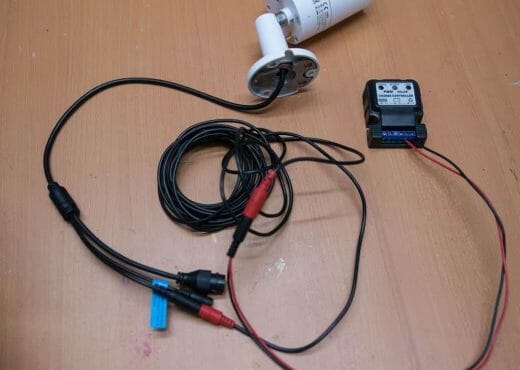
The final step is to make all the right connections using the wires to get the solar-powered camera up and running.
Be extremely careful while linking the wires, as one misstep could bring you back to square one. Collect all the wires and cables before you begin working on this phase of the project.
Here are the three wiring connections that you would need to secure for the proper functioning of your solar-powered security camera.
1. Connecting the solar charge controller to the battery

The solar charge controller, being the main regulator, would first need to be attached to the 12V battery using a suitable cross-section cable. The battery’s positive terminal would need to be connected to the positive terminal of the solar charge controller. Similarly, connect the negative terminals.
2. Connecting the solar panel and the solar charge controller
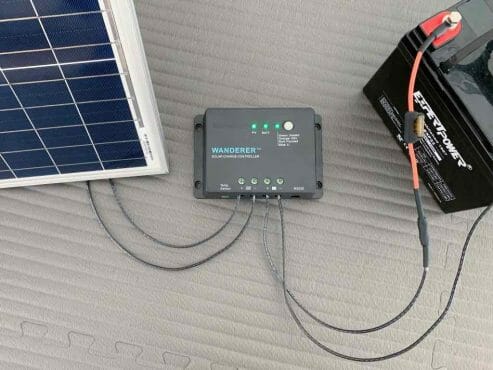
Next, you’d have to establish a connection between the solar panels, and the solar charge controller. Similar to the previous step, you’d be required to connect both the corresponding positive terminals, and both the negative terminals.
Once the connection is made, and the panels are receiving sunlight, the charge controller would indicate the “battery charging” signal. That would tell you if all the wiring was done properly or not.
3. Connecting the security camera to the load terminals
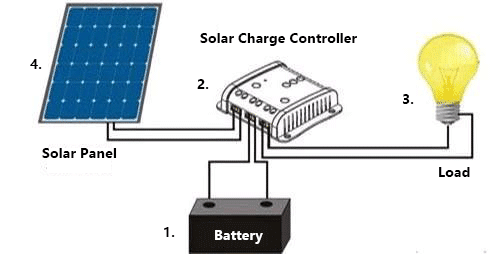
Now that you’ve set the base, you can make the final connection, that of the security camera and the load terminals of the solar charge controller. Repeat the exercise of connecting the corresponding positive terminals, and the negative terminals.
Voila, you’re all done. Once the system gets some juice through sunlight, you can get your security cameras up and running, and begin monitoring and recording the events in front of your house.
Additional Factors to Consider
Factor 1: Voltage of your Solar Security Camera
Managing power supply is important while making a DIY solar system.
The thing to consider here is the battery’s power supply voltage. It needs to be on the same level as the wireless security camera that you want to install. For instance, if you’re planning on installing a 12V camera, it needs to be paired with a 12V battery. If you pair a 12V camera with a 24V battery, the cameras would get cooked.
Likewise, if a 24V camera is paired with a 12V battery, it won’t work due to an inadequate power supply. This is why it is imperative to know the power voltages of both devices before building a DIY solar security camera.
Factor 2: Battery Backup Options for Your DIY Solar Cameras
While your solar security camera would get its power from the sunlight, some backup options should be put in place to ensure that the camera continues to monitor and record even when it is cloudy, or when the sun is not shining, or at night.
For this, you’d first need to gauge the battery lifespan of the surveillance system. To ensure that power is efficiently pumped at all times necessary, purchase rechargeable solar batteries, that can be recharged fairly quickly to keep the system up and running. Choose the right solar panel kit, which can be bought from Amazon, or a local hardware store.
On average, you can expect the battery of a wireless security camera powered by solar energy to carry on between 4 and 6 months in standby mode. Although, this figure could be easily pushed much higher, depending upon a number of factors, including the usage.
Factor 3: Protection From Weather Elements

Since solar-powered security cameras are meant to be placed outside, they will inevitably be prone to the elements, such as rain, wind, storm, dust, and even lightning. During winters, it can be exposed to excessive snow. Needless to say, such elements can prove to be catastrophic to the proper functioning of the camera, so you’d have to take some protective measures.
For one, make sure that the camera you buy is waterproof. Next, build protective housing for your solar panel and the whole system, such as a weather-proof box. Lastly, ensure that the security camera and other components are regularly cleaned and dusted.
Factor 4: DIY Solar-Powered Security Cameras Cost
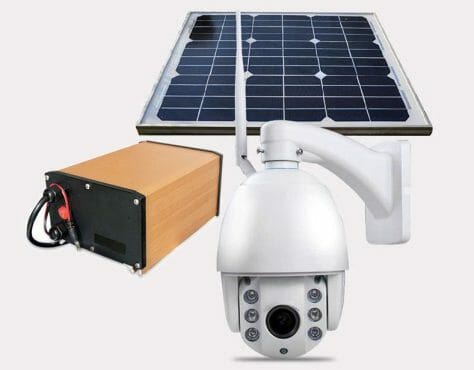
DIY solar-powered security cameras are not cheap to buy, so prepare to pony up a bit now for more future savings later. On average, you can expect this whole project to cost you anywhere between $400 to $1000. The figure could be more than this range too, depending upon the quality and the brand of components you’ve bought. This is especially true for solar-powered cellular cameras that work on 3G/4G/LTE networks due to the additional service costs. (3)
Best Wireless Cameras To Choose For The DIY Project
To complete your DIY solar security camera project, you’d have to choose the ideal wireless security camera. Here are two of the many options to choose from. Depending upon your budget and your unique requirements, you can blindly buy any of these two, although, Reolink has a better track record in working as a DIY solar camera.
1. Reolink
The Reolink wireless camera is trusted by countless home surveillance owners due to its high specifications, and ease of use. Reolink camera is a petite and easy-to-install device both indoors or outdoors, without having to deal with the hassle of a lot of wires. It offers effective pixels, 4.0 megapixels to be precise, and supports both day and night viewing, thanks to the IR illuminator that can cover a distance of about 30 meters. The best part is, the Reolink offers good flexibility in installation, which means it is a perfect wireless camera to be installed in your DIY solar surveillance project. It is compatible with all the components that would be required to build the DIY security camera.
2. Arlo Security Camera
Arlo can also be used for the DIY project. Arlo Pro 4 for instance can be installed without the need for any wires, which will make it easier for you to integrate the camera with the rest of the apparatus that you create. The small size would also offer much flexibility in where you decide to install it. Moreover, since the solar camera would be exposed to harsh weather, it would be much easier for you to protect a small camera like Arlo from the rain, dust, storm, and snow. It also comes with night vision and a 160° diagonal viewing angle. So, not only will it fit right into the solar camera apparatus, but also render good performance in terms of recording.
FAQs
Can security cameras function with no electricity?
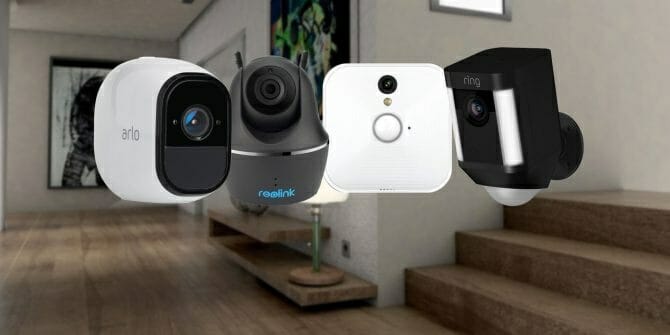
Whether or not a security camera will work without electricity depends upon what kind of camera we are speaking of.
If it’s a CCTV camera, then no. All CCTV cameras require electricity to function. However, there are an array of other types of security cameras that can work either using a battery or have some other source of power.
Reolink Argus 2 for instance uses a rechargeable battery to function, so it doesn’t matter if your home has electricity or not. If you connect the camera to a solar panel, then too, it would work just fine without electricity.
A solar camera uses the energy provided by the sunlight to keep the system running. So, it doesn’t require electricity to work, as long as the solar batteries are charged. This will allow you to capture images and videos even during prolonged power outages.
Although, some cameras also have backup batteries, which can be turned on during power outages. To that end, there are plenty of ways of ensuring that your security cameras continue to record and monitor even when the electricity goes out.
What is the expected lifespan of solar-powered security camera batteries?
The duration of how long the battery of your security camera would last depends on several factors, including the battery you have, and the total usage of the security camera.
On average, you can expect the battery to last about 4-6 months on standby. An average set of rechargeable batteries would take 6 to 8 hours to charge, and then would be run for about 1 week to 3 months, with no additional charging. Of course, these are only some average figures that we have pulled. The precise figure would vary depending upon how long the camera has actively recorded.
Is it mandatory to install a solar security camera in direct sunlight?
The solar battery-powered camera gets its juice from the sunlight, so of course, you’d need to keep the solar panels in direct sunlight. The more direct the sunlight is to the panels, the more power. You can point the panels to the equator for more efficacy.
Although, even if there is no direct sunlight falling onto the panels, you’ll get adequate power. Even on cloudy days, you can expect your camera to work due to the UV rays that can push through the clouds and power up the system, though, it won’t be as efficient as direct sunlight.
Can I expect solar-powered security cameras to function even in winter?

Solar security camera undeniably works best under strong sunlight, which you can only expect during the hot summer months. So, you might wonder if the system would work during winters when sunlight is relatively sparse. The answer is yes. Your solar-powered security camera would work just fine in winters, even when it’s snowing, and better in some cases.
This is because the snow on the ground could play the role of a mirror, and provide more energy output. This is of course if the solar panel itself is not covered in snow. If that’s the case then the proper functioning of the camera would be hampered. On days when there is no snow though, you have got nothing to worry about.
Even so, you could take certain measures to ensure that the proper functioning of the surveillance system is not hindered. You could protect the panels by building a weatherproof protective cover around them. The cover would wick away as much snow as it can, or enough to ensure the continued functioning of the camera.
To Buy or To Build? (Advantages & Disadvantages)
Solar battery-powered cameras have an assortment of benefits. For one, you could give yourself a healthy challenge of assembling everything on your own. Moreover, you’d get much flexibility on the specifications of the system. So, you get to make the calls on how the camera eventually performs.
In addition to this, a solar security camera also eliminates the hassle of dealing with long wires, and these cameras can be installed even in remote locations. However, solar cameras are not completely disadvantage-free. There are a lot of cons that you need to be wary of.
For one, solar camera kits can be really expensive. Not that the store-bought cameras are not expensive, but if you’re choosing to make your system more specifically advanced, then you’d have to cough up the extra money. However, in the long run, you’d notice that a DIY solar camera is less an expensive investment than a store-bought camera. This is so, the store-bought camera can only pump so much power. If you want the camera to render more power, you’d have to pay the price too. Meanwhile, in a DIY solar camera, you can choose the number of panels and subsequently, decide how much energy you want to utilize. Moreover, by using a DIY solar camera you could also relieve yourself of not paying a monthly subscription fee, which is a must in some store-bought cameras, especially the ones that work over a cellular network.
Wrapping up
Security cameras can give you a sense of security, and ensure that you and your family are safe from intruders. If it’s solar-powered, it’s even better since you could then manage the battery, and not worry about frequent power outages. The best part is, you could easily build your own solar security camera with no professional help, thanks to solar camera kits.
References
(1) Li-Ion – https://www.sciencedirect.com/topics/chemistry/lithium-ion-battery
(2) PV panel – https://www.sciencedirect.com/topics/engineering/photovoltaic-panel
(3) 3G/4G/LTE networks – https://www.verizon.com/articles/network-speeds-101-comparing-3g-and-4g-lte/

